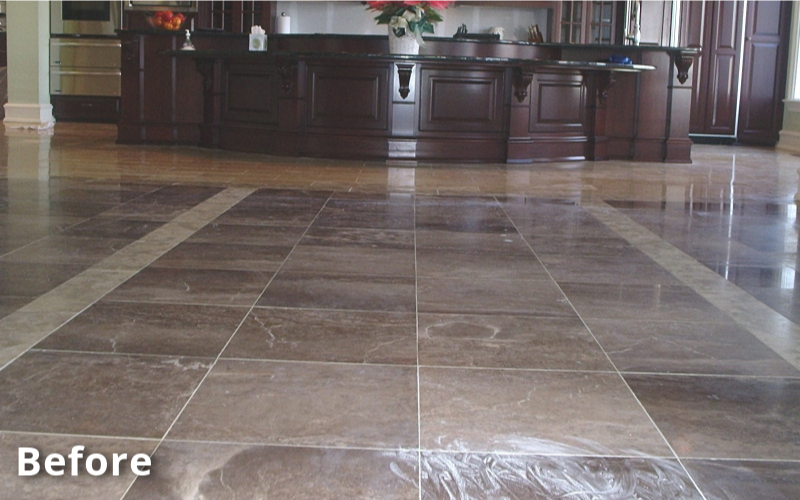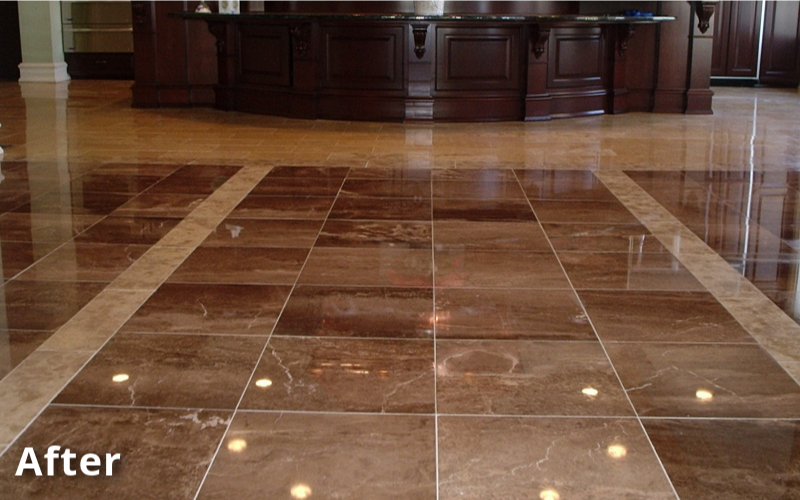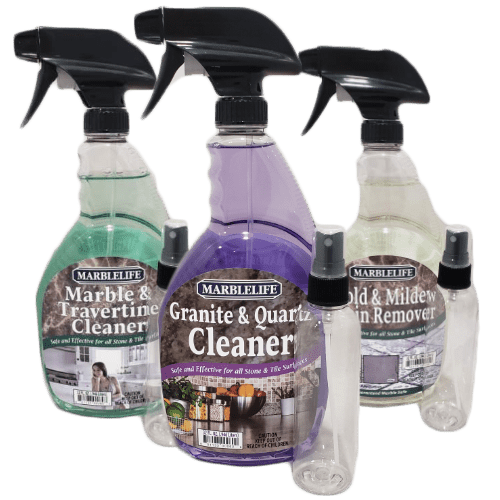- Home
- Marble
- Concrete
- Tile & Grout
- Tile And Grout cleaning
- Tile And Grout Maintenance
- Tile And Grout Sealing
- Commercial Tile And Grout Care
- Residential Tile And Grout Care
- Colorseal
- Mold Blocking Treatments
- Medical Tile And Grout Care
- AntiGraffiti Treatment
- TileLok™ - High Durability Coating
- Grout Stripping
- Mexican Tile Terra Cotta
- Large Format Tile Restoration
- Granite
- Galleries
- Other
- Commercial Markets
- Terrazzo
- Travertine
- Vinyl
- Slate
- Corian Countertops
- MARBLELIFE® Products
Residential Polishing Services
Need to change your finish? Too dull or too shiny? Have a new floor with some tiles that are higher in gloss than others? Let Marblelife even out the finish for you. Whether you are seeking a polished/gloss, semi-gloss, or matte finish, we can deliver.
Request a FREE EstimateABOUT MARBLE POLISHING
Does your marble have an uneven finish? Do you notice dull spots, scratches, or etches diminishing the elegance of your marble surfaces?
Marble is a hard-crystalline metamorphic rock composed of calcium carbonate (the same material as hard water deposits). It comes in a variety of colors from diverse locations. Natural stones like marble can easily last a lifetime if properly maintained. However, being acid-sensitive they can also be dissolved and damaged by substances like vinegar, tomatoes, and citrus fruit.
Being relatively soft, marble is easily scratched by dust and sand underfoot. In fact, a hotel can develop wear patterns from front door to registration desk in as little as 45 days, if not being properly maintained.
MARBLELIFE® is comprised of the largest network of marble craftsman in North America. We trace our roots to one of the first two companies to offer stone restoration services in North America, and are responsible for developing many of the techniques employed today.
Let us eliminate imperfections and restore the natural beauty of your marble.
WHY MARBLELIFE?
- We provide you with the most efficient and trained staff in all the new processes out there, by training our staff in our state-of-the-art R&D Facility in Sanford Florida so that we can bring expert restoration to your doorstep.
- We can handle any situation that you need. Don't believe us? Just check out our trusted clients such as, Rockefeller Center, J. Paul Getty Museum, Ford World Headquarters, Grand Central Station, Marriott, and Ritz Carlton.
- We do the tough work so you don't have to. Oftentimes we see that clients that believe their surface is dirty, when actually it is damaged. Our free assessments can save you hundreds of hours of scrubbing something that may never look clean without professional service.
- We will restore your floors, vanities, showers, and even counters to pristine condition. With more than 1000 restorations a month, MARBLELIFE is the largest residential services provider in the world.
COMMERCIAL MARBLE & HARD SURFACE POLISHING
MARBLELIFE® restores and maintains more hotels and commercial buildings stone and hard surface floors every month than anyone else in the country. With 30 years’ experience, and more than 50 locations, we deliver world class results with local MARBLELIFE trained and certified stone craftsmen.






Our Value Statement
We sincerely believe that our commitment to excellence in every aspect of our company is the primary basis for our survival in the marketplace. We believe in the worth and potential of every individual. Every person we empower to achieve his or her potential will bring MARBLELIFE® closer to achieving its potential as a leader in our industry.
We understand that our principal product is one of service to our customers, our community, and each other as members of the MARBLELIFE® family. We believe that we are our own best competitors... getting things done, overcoming adversity, growing through vision, and doing the challenging is something we welcome with enthusiasm.
Over the past 30+ years, MARBLELIFE® has become the largest stone restoration and maintenance company in North America, and expanding globally. Our growth is built upon and driven by the referrals and satisfaction of each client we work with.
GET YOUR FREE ESTIMATE TODAY
Use our form below to recieve a customized quote for your project.
Frequently Asked Questions
My marble is looking dull, will I need more than just a “clean-and-polish”?
Do you have visible scratches? If you do they will require a honing process to remove. Polishing a scratch makes it more noticeable. That said, polishing is sufficient to overcome minor dulling wear.
What is the difference between a “clean-and-polish” and a “hone-and-polish”?
Clean-and-Polish requires a surface to be re-polished but that does not generally mean that scratches are removed. If scratches exist, one could end up with shiny scratches which are more noticeable.
Hone-and-Polish seeks to first remove the scratches and the polish up the surface to restore a better-than-new surface.
How can we say that it is better-than-new? Because we will also seal the surface and then address any grout related issues. MARBLELIFE can restore a stain-free grout appearance, and can in fact even change grout colors from white-to-black, black-to-white or a change to what ever color you are seeking to accent with. This MARBLELIFE COLORSEAL grout line has acid-resistant surface allowing even the most damaging cleaners to be used without creating a problem. 25 % of MARBLELIFE’s residential restoration work is required due to the use of a damaging cleaner.
Hone-and-Polish seeks to first remove the scratches and the polish up the surface to restore a better-than-new surface.
How can we say that it is better-than-new? Because we will also seal the surface and then address any grout related issues. MARBLELIFE can restore a stain-free grout appearance, and can in fact even change grout colors from white-to-black, black-to-white or a change to what ever color you are seeking to accent with. This MARBLELIFE COLORSEAL grout line has acid-resistant surface allowing even the most damaging cleaners to be used without creating a problem. 25 % of MARBLELIFE’s residential restoration work is required due to the use of a damaging cleaner.
Can polishing remove spots and dull areas on my floor?
Absolutely
<
Spots and dull areas are generally caused by either an acid having dissolved the marble stone surface, or wear and microscratches damaging the surface. Once a hole or scratch has been created the stone surface has to be lowered to the bottom of the deepest surface to restore a flat mirror reflective surface. The good news is that even the worst damage is generally not as deep as the width of a human hair so a tile can last more than 50 years even in service within a high wear hotel or convention center.
<
Bring us your dull and damaged marble, granite and concrete and MARBLELIFE will restore a better-than-new polished surface.
<
Spots and dull areas are generally caused by either an acid having dissolved the marble stone surface, or wear and microscratches damaging the surface. Once a hole or scratch has been created the stone surface has to be lowered to the bottom of the deepest surface to restore a flat mirror reflective surface. The good news is that even the worst damage is generally not as deep as the width of a human hair so a tile can last more than 50 years even in service within a high wear hotel or convention center.
<
Bring us your dull and damaged marble, granite and concrete and MARBLELIFE will restore a better-than-new polished surface.
What’s the difference between polishing, waxing and coating – don’t they all create “shine?”
When seeking to secure a shine on a surface how it is achieved will determine how long it lasts. The length of time is determined larger by the hardness of the finished surface and its ability to resist wear.
Wax is a non-reactive chemical that lays on the surface. Its surface is melted to form a mirror smooth surface, BUT it is very soft and will lose that mirror finish with minimal foot traffic. Wax does not breath. When applied to a ground floor surface this failure to breath can result in damage to the marble when water vapor pressure rises through the floor but cannot exit the stone. This pressure if consistent of time will find the weakest part of the stone which is the vein-to-background stone surface and push through. This is literally strong enough to push a the vein right out of the stone.
Coatings are reactive treatments that generally have greater wear resistance than wax. The issue is that once worn unless the coating can be repaired, which is rare, the entire coating must be removed and re-applied. Re-coating may be done if the coating is intact but only a limited time before it becomes to thick.
Polishing on the other hand works directly on the stone surface, which is much harder than a coating or wax, and therefore is more wear resistant. MARBLELIFE can further enhance this with our surface modifying hardness enhancing treatments. A polished surface is more cost effective but requires the attention of a grinding/polishing expert such as MARBLELIFES CRAFTSMAN.
Wax is a non-reactive chemical that lays on the surface. Its surface is melted to form a mirror smooth surface, BUT it is very soft and will lose that mirror finish with minimal foot traffic. Wax does not breath. When applied to a ground floor surface this failure to breath can result in damage to the marble when water vapor pressure rises through the floor but cannot exit the stone. This pressure if consistent of time will find the weakest part of the stone which is the vein-to-background stone surface and push through. This is literally strong enough to push a the vein right out of the stone.
Coatings are reactive treatments that generally have greater wear resistance than wax. The issue is that once worn unless the coating can be repaired, which is rare, the entire coating must be removed and re-applied. Re-coating may be done if the coating is intact but only a limited time before it becomes to thick.
Polishing on the other hand works directly on the stone surface, which is much harder than a coating or wax, and therefore is more wear resistant. MARBLELIFE can further enhance this with our surface modifying hardness enhancing treatments. A polished surface is more cost effective but requires the attention of a grinding/polishing expert such as MARBLELIFES CRAFTSMAN.
What’s the difference between “shine” and “clarity”?
Shine suggests that you can see the reflection of a light source, even if it is hazy or fuzzy.
Clarity speaks to the sharpness of the image.
When MARBLELIFE hones and polishes your marble floor we can attain a surface flatness sufficient to deliver a mirror finish with clarity so fine you can read the label on your light bulbs in the reflection on your floor or counter.
Clarity speaks to the sharpness of the image.
When MARBLELIFE hones and polishes your marble floor we can attain a surface flatness sufficient to deliver a mirror finish with clarity so fine you can read the label on your light bulbs in the reflection on your floor or counter.
News About Marble & Natural Stone
WAR-ON-COVID Clean-It-Forwardtm
Help defeat COVID-19 by Cleaning-It-Forward. Instead of using a paper towel to shield contact from a shared surfaces such as gas pumps, ATM touchpads, and Grocery Card handles, how about we spray it down with a quick-acting cleaner and wipe the surface down. Protects us, removes contamination, and protects the next person. Lets remove COVID19 from our lives. Secure a 4 oz refillable bottle for each family member – and lets enter the fight.
Shop Now
MARBLE & TRAVERTINE CARE
Specialty Cleaners and Sealers formulated to provide exceptional results without damaging or etching your marble or travertine surfaces.
Shop NowGRANITE & QUARTZ CARE
Specialty Cleaners and Sealers formulated to allow your granite’s natural beauty to shine without burying it under damaging waxes and oils. Be sure to re-seal every 2 years to avoid potential expensive staining.
Shop NowPIEDRA Y AZULEJOS - CUIDADO DE LA DUCHA
Our showers see moisture, soaps, shampoos, moisturizers, conditioners, hard water and mold spore interactions daily, making it one of the harder surfaces to maintain… unless you have the right products for the job. MARBLELIFE sealers, cleaners and specialty products for shower care.
Shop NowHAVE A BIG JOB?
Have a hotel or commercial property? MARBLELIFE can provide service programs for 1 to 100 properties throughout our network of 50+ locations worldwide.

Whether its one location or a 100 across the USA, we can cover them all

